Tuesday, August 30, 2005
Photo Finish
I've been in contact with the solar tour folks, and they wanted a couple of pictures of my project. I realized that with all of my in-progress photos, I didn't really have any "mission accomplished" photos. So here they are!




Monday, August 29, 2005
Solar air heating?
When the winter comes, my power needs will go up (especially the blower motor on my gas furnace) while the solar power goes down. I'm starting to look at various ways to keep the house warm without hitting the grid too often or too hard. Running a space heater as a dump load would be one way. Using some form of solar air heating would be another.
ClearDome Solar offers several products to convert sun power efficiently into home heating. Check out their external forced-air heaters, solar heating drapes and radiant panels at their Amazon sales page. Let me know if you've heard or read anything about these systems.
ClearDome Solar offers several products to convert sun power efficiently into home heating. Check out their external forced-air heaters, solar heating drapes and radiant panels at their Amazon sales page. Let me know if you've heard or read anything about these systems.
Friday, August 26, 2005
Come check it out!
I'm hoping maybe to have an open house one of these days, but it may not be until the solar tour in October. Anyone interested in seeing the project up close is welcome to stop by--just e-mail me first to set up a time: bob AT goodsells DOT net.
Wednesday, August 24, 2005
Passed Inspection!
The electrical inspector was here this morning, and signed off on the project! Thanks to Rick for seeing to all the details to make sure I didn't have any problems in the inspection.
Sunday, August 21, 2005
94% Grid Free!
Sunday, August 14, 2005, 2:30 PM:

Sunday, August 21, 2005, 2:30 PM:

So my electric meter went from 01347 to 01350 kilowatt-hours in one week--3 kwh. Typically, I would use about 50 kwh in a week. The charge controller's log shows that 47 kwh were generated by the solar shingles. So, for the past week, I got 47/50 of my electricity from the sun: 94%.
Unfortunately, the Mate controller doesn't provide an easy way to track the actual AC out energy used, which would more accurately compare to the electric meter. It does provide a crude graphical indication of instantaneous AC out, but it doesn't integrate it over time like the charge controller does for solar power. Rick and I are looking into various ways to track the system performance.
We still don't have the dump load figured out, so I've been controlling the dehumidifier manually, trying to get it to run at the right times so it won't bring the battery voltage too low. The 3 kwh on the meter are a measure of the degree to which I failed.
It's a very nice, sun-shiny day today. I've been tracking the solar kwh's throughout the day--I'm hoping for a new record!

Sunday, August 21, 2005, 2:30 PM:

So my electric meter went from 01347 to 01350 kilowatt-hours in one week--3 kwh. Typically, I would use about 50 kwh in a week. The charge controller's log shows that 47 kwh were generated by the solar shingles. So, for the past week, I got 47/50 of my electricity from the sun: 94%.
Unfortunately, the Mate controller doesn't provide an easy way to track the actual AC out energy used, which would more accurately compare to the electric meter. It does provide a crude graphical indication of instantaneous AC out, but it doesn't integrate it over time like the charge controller does for solar power. Rick and I are looking into various ways to track the system performance.
We still don't have the dump load figured out, so I've been controlling the dehumidifier manually, trying to get it to run at the right times so it won't bring the battery voltage too low. The 3 kwh on the meter are a measure of the degree to which I failed.
It's a very nice, sun-shiny day today. I've been tracking the solar kwh's throughout the day--I'm hoping for a new record!
Tuesday, August 16, 2005
Grid Free?
My grid-free test got off to a shaky start. I began it after a cloudy weekend, and I tried to get away with running the dehumidifier and the dishwasher Monday morning, counting on a sunny day. Unfortunately, the loads drew down the batteries enough to cause the system to switch to grid for a while before the sun really kicked in. Here's what it looked like Sunday:

Here's what it looked like Monday about 5 pm, and still looks like (3:30 pm Tuesday):
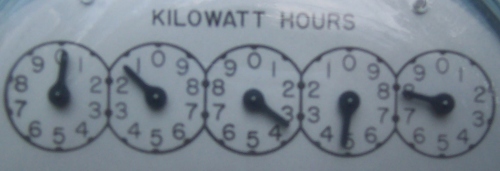
So, I used just under 1 kwh of grid power on Monday, and none at all between 5 pm Monday and 3:30 Tuesday. Getting the dump load setup configured should allow me to run the dehumidifier as much as possible without accidentally drawing grid power.

Here's what it looked like Monday about 5 pm, and still looks like (3:30 pm Tuesday):

So, I used just under 1 kwh of grid power on Monday, and none at all between 5 pm Monday and 3:30 Tuesday. Getting the dump load setup configured should allow me to run the dehumidifier as much as possible without accidentally drawing grid power.
Monday, August 15, 2005
Links updated
I've added on several new links to the list on the left, including the major equipment manufacturers and vendors. Some of you, like me, probably live in North Snowistan hundreds of miles from anything resembling a solar energy store. I would generally prefer to buy local, but in this case that really wasn't an option. Of the four out-of-state Internet stores that I bought equipment from, I would recommend the Solar Panel Store in Colorado and Perfect Power in Phoenix as being the most helpful. Cindy Phillips at Perfect Power was very helpful when I needed four additional shingles and nobody seemed to have them, and in getting the batteries here.
The Alternative Energy Store gave me a below-listed-price deal on the first 80 shingles, but dragged their feet on giving me an estimate on a pre-assembled Outback Power Panel (I ended up buying all of the components separately). Affordable Solar had the lowest prices, but they messed up on two orders, putting the wrong stuff in the boxes.
The Alternative Energy Store gave me a below-listed-price deal on the first 80 shingles, but dragged their feet on giving me an estimate on a pre-assembled Outback Power Panel (I ended up buying all of the components separately). Affordable Solar had the lowest prices, but they messed up on two orders, putting the wrong stuff in the boxes.
Sunday, August 14, 2005
Dump load versus grid tie
A couple of readers have asked me why I'm worried about dump loads when I should be able to sell my excess power to the local utility (DTE Energy). This was my reply:
Michigan didn't pass a net-metering bill until a couple of months ago, after I had ordered my equipment. I don't know how it will be implemented by DTE, or when, and the inverter I have is not designed to sell to the grid. If the law had been in place when I started, I might have gone with a different inverter (Outback actually now makes a battery/grid-tie inverter similar to mine). But I don't think there will be too many times when I have so much extra power that I can't benefit from it--make the basement a little drier in the summer, the house a little warmer in the winter.
For now I'm using the grid as backup to my solar. After I've operated the system for a year or so, I may find that I can make it without the grid at all--in which case I can save the basic monthly connection fee.
The most cost-effective solar electric installations are the grid-tie ones without batteries. Basically all you need are panels and a grid-tie inverter. But you get no blackout protection, since the utilities require that your system shut down when the power is out (to protect line workers, I think).
I based a lot of my decisions based on what I really wanted, not on the economics. The most cost-effective thing to do would have been to take the simple conservation measures (insulation, compact fluorescent bulbs, Energy Star appliances, switching off phantom loads) and staying with the grid. However, if the energy crisis kicks in in earnest in the next couple of years, I may still come out ahead, having bought my solar equipment at what may in retrospect look like low prices, and not paying sky-high electric bills. If not, I've still got a cool blackout-proof self-powered house for about the cost of a new car.
Michigan didn't pass a net-metering bill until a couple of months ago, after I had ordered my equipment. I don't know how it will be implemented by DTE, or when, and the inverter I have is not designed to sell to the grid. If the law had been in place when I started, I might have gone with a different inverter (Outback actually now makes a battery/grid-tie inverter similar to mine). But I don't think there will be too many times when I have so much extra power that I can't benefit from it--make the basement a little drier in the summer, the house a little warmer in the winter.
For now I'm using the grid as backup to my solar. After I've operated the system for a year or so, I may find that I can make it without the grid at all--in which case I can save the basic monthly connection fee.
The most cost-effective solar electric installations are the grid-tie ones without batteries. Basically all you need are panels and a grid-tie inverter. But you get no blackout protection, since the utilities require that your system shut down when the power is out (to protect line workers, I think).
I based a lot of my decisions based on what I really wanted, not on the economics. The most cost-effective thing to do would have been to take the simple conservation measures (insulation, compact fluorescent bulbs, Energy Star appliances, switching off phantom loads) and staying with the grid. However, if the energy crisis kicks in in earnest in the next couple of years, I may still come out ahead, having bought my solar equipment at what may in retrospect look like low prices, and not paying sky-high electric bills. If not, I've still got a cool blackout-proof self-powered house for about the cost of a new car.
Grid-free?
I've been encouraged by the first day and a half running my system on the new batteries. The encouraging thing is that it has been an overcast, rainy weekend, but I haven't come close to having to switch to grid power. To be sure, the batteries were fully charged when I started--but they're pretty much fully charged now! I figured now is a good time to start a test--how long can I go without using grid power? Here's a photo of my electric meter, taken about 2:15 PM on August 14:

I think that reads 01347. In any case, I'll try to check it each day or two and see if I've used any grid power. The system is currently configured (at least I hope I did it right!) to run off of the batteries until they get down to 46.4 volts, which is approximately 50% charge for the eight nominally 6-volt batteries in series, according to the manufacturer. At that point, the inverter will automatically switch to grid power until the battery charge has recovered somewhat. Given what I've seen from this weekend, it shouldn't have to switch to grid power any time soon!

I think that reads 01347. In any case, I'll try to check it each day or two and see if I've used any grid power. The system is currently configured (at least I hope I did it right!) to run off of the batteries until they get down to 46.4 volts, which is approximately 50% charge for the eight nominally 6-volt batteries in series, according to the manufacturer. At that point, the inverter will automatically switch to grid power until the battery charge has recovered somewhat. Given what I've seen from this weekend, it shouldn't have to switch to grid power any time soon!
Saturday, August 13, 2005
Almost Finished! And I mean it this time!!!
Rick built me the world's finest battery box:
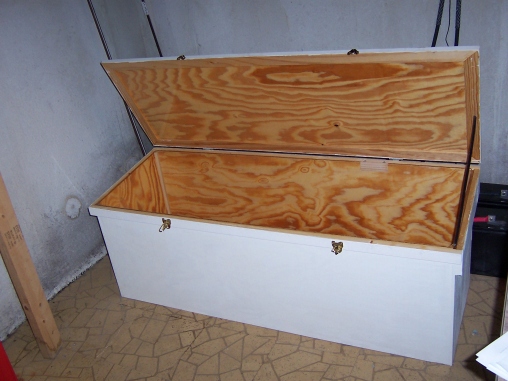
He brought it over Thursday evening, and we finished hooking it up last night (Friday). Quarter-inch plywood, reinforced where necessary, coated on the inside with an acid-resistant epoxy, and on the outside with white semi-gloss latex paint. The top slants towards the back to guide hydrogen gas to the vent at the back. Properly venting the hydrogen generated when the batteries are heavily charged (like during equalization) is the primary reason for a battery box. Protecting against accidental contact with battery acid or dropping something metal across battery terminals are other reasons why a battery box is needed. If I had been able to stay with the sealed batteries, a full box probably wouldn't have been needed, but a protective cover would have (ultimately up to the electrical inspector, who I'll be ready to call in another week or two, hopefully).
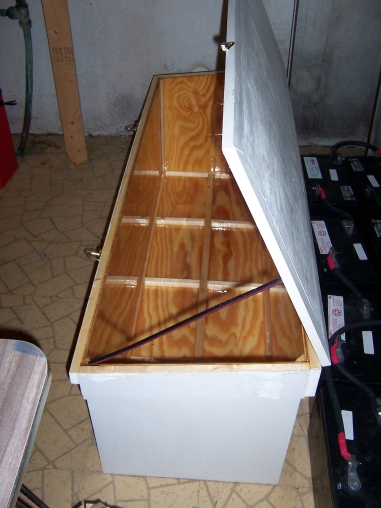
Rick put some nifty battery dividers in the bottom of the box:
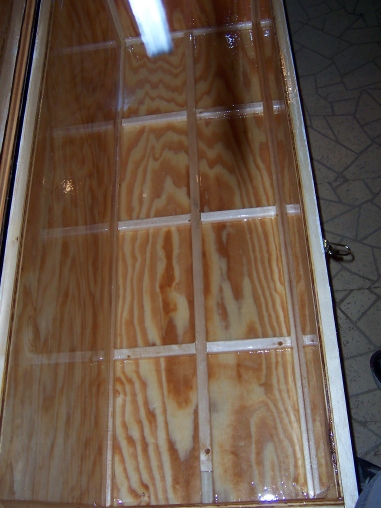
The batteries in the box.
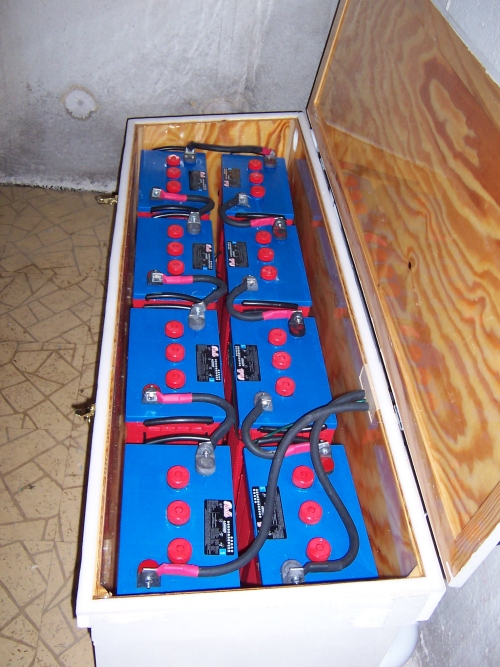
The exhaust vent can be seen in the back left of the box, and the holes where the cables come through in the upper right of the back:
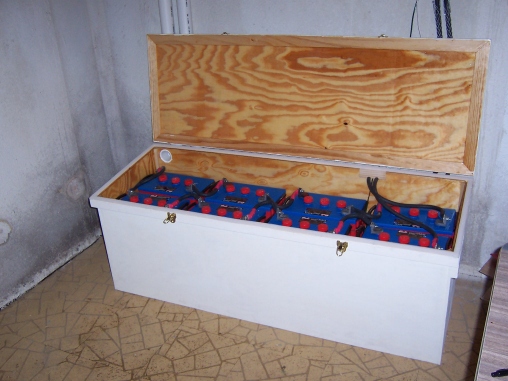
At the bottom of the picture below is the fresh air intake for ventilating the battery box. A small 12-volt fan is in the fitting where the tubing enters the box. The fan is controlled by the inverter, and runs when the batteries are overcharged (60 volts on the nominal 48-volt system). This should only happen during battery equalization, a process run every few months to keep the batteries working properly. For normal operation, gravity should suffice to ventilate the box of any hydrogen generated.
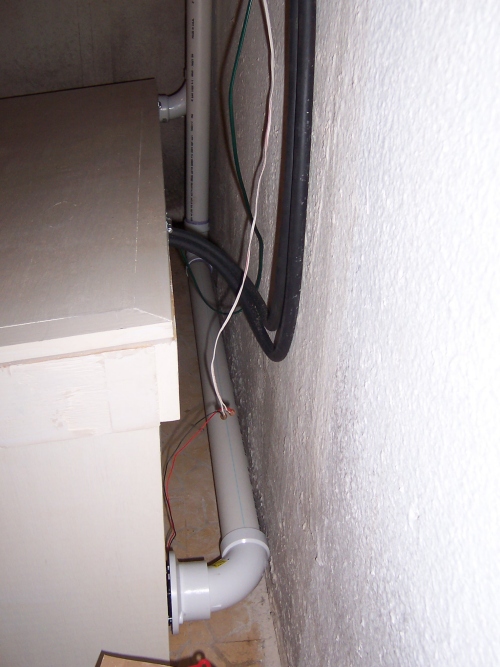
The exhaust vent from the box:
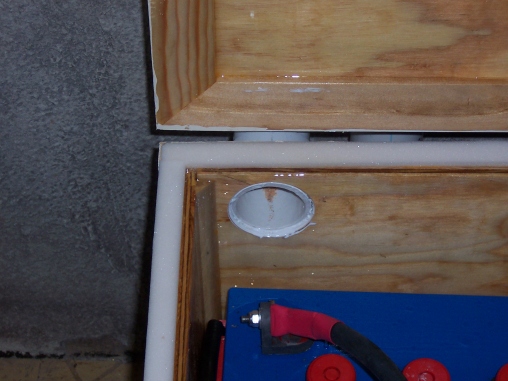
Of course, the vents have to go outside, so Rick drilled a couple of holes in the back of my house (this was about 10:30 pm last night):
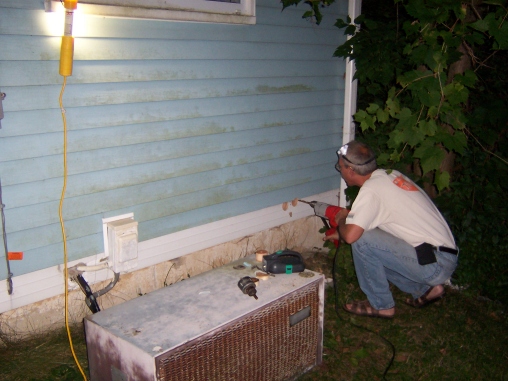

This is what it looks like from the inside:
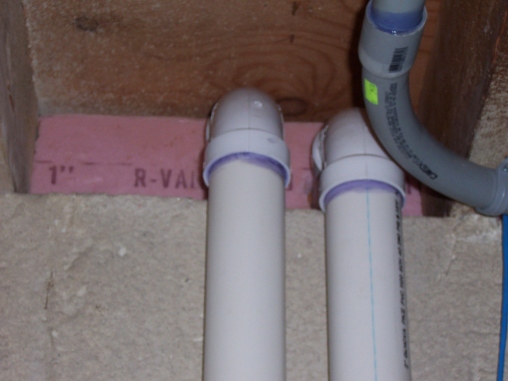
By the light of day, we see the vents in place. Rick intends to add a downward elbow on the intake (left) to keep rain out. A small ventcover is already in place. For the exhaust, he thought it was not a good idea to use a down elbow, since that could cause hydrogen to be trapped. Instead, he just cut the end at an angle. He'll add some window screen to keep the critters out.
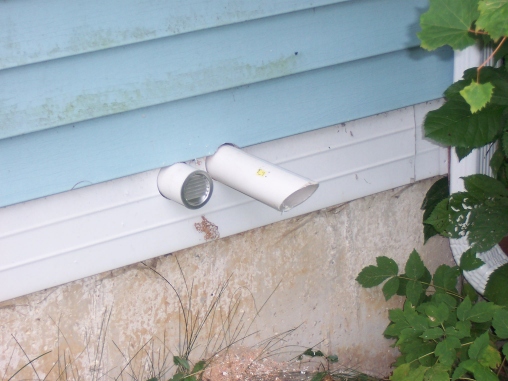
All of the connections to the box can be seen in the photo below. at the bottom, you see the air intake, the wires powering the 12-volt intake fan. The big black cables are the main battery cables, connecting the batteries to the Outback PS2DC box, which connects them (through breakers) to both the solar array and the inverter. The small black wires connect to a remote temperature sensor attached to one of the batteries inside the box. Maximum charging voltage varies with temperature, so the temperature sensor tells the rest of the system how hot (or cold) the batteries are. At the top, the exhaust pipe can be seen coming out of the back of the box and turning up behind the intake pipe.
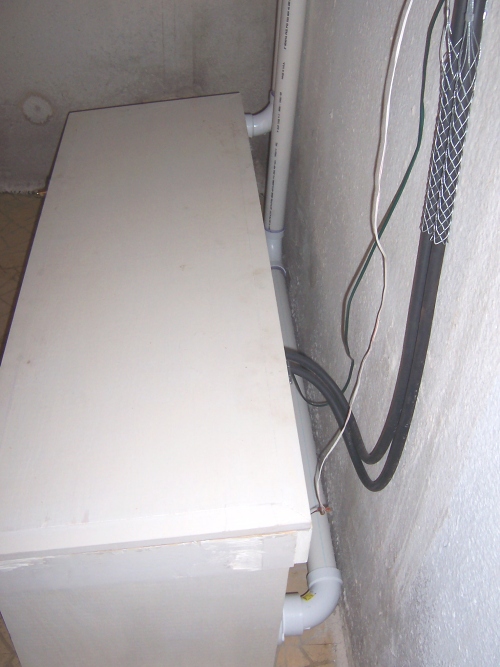
With everything in place and connected, we can close the lid and let the batteries go to work!
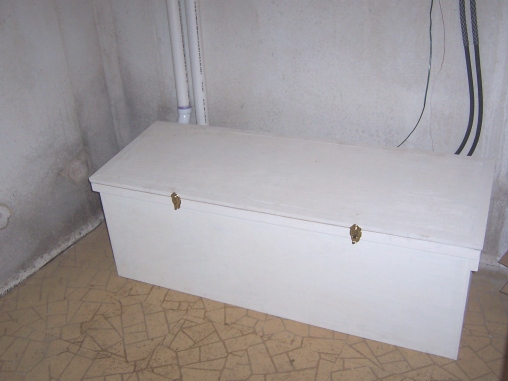
We started running on them last evening while we were still finishing up--the power to drill the vent holes came from the batteries through the inverter, as well as all the lights. They ran the house without any complaint all through the night and well into a rainy morning, dropping only a tiny bit of voltage while I ran the dishwasher, washing machine, dehumidifier, and other things. This afternoon the sun has come out, so the batteries are being treated to their first taste of beautiful solar power!
Still to do: Finish covering up the shingle wires in the attic, and figure out a way to use a dump load. A dump load is a place to use excess solar power when the batteries are fully charged and the sun continues to shine. The ideal dump load is something that provides a needed service but doesn't really have to run at any particular time. My intention has been to use the dehumidifier in the summer and an electric space heater in the winter as my dump loads. But I asked Rick to look into the possibility of using X-10 home automation technology to control the dump load. X-10 sends signals through the house wiring to turn on and off lights and appliances. Radio Shack and others sell the equipment, including a variety of controllers--wall switches, remote controls, and computer interfaces. The Outback solar equipment has a means of generating a signal when dump-load conditions are met. If we can figure out how to turn this into an X-10 signal, I can then use any appliance or combination of appliances as the dump load by setting them to the appropriate X-10 channel.
One very interesting possibility for a dump load a few years from now might be a plug-in hybrid electric vehicle, or PHEV. This could make driving a car, at least for short distances, almost completely renewable--if you have a good source of renewable electricity handy. Which I do, on my roof!

He brought it over Thursday evening, and we finished hooking it up last night (Friday). Quarter-inch plywood, reinforced where necessary, coated on the inside with an acid-resistant epoxy, and on the outside with white semi-gloss latex paint. The top slants towards the back to guide hydrogen gas to the vent at the back. Properly venting the hydrogen generated when the batteries are heavily charged (like during equalization) is the primary reason for a battery box. Protecting against accidental contact with battery acid or dropping something metal across battery terminals are other reasons why a battery box is needed. If I had been able to stay with the sealed batteries, a full box probably wouldn't have been needed, but a protective cover would have (ultimately up to the electrical inspector, who I'll be ready to call in another week or two, hopefully).

Rick put some nifty battery dividers in the bottom of the box:

The batteries in the box.

The exhaust vent can be seen in the back left of the box, and the holes where the cables come through in the upper right of the back:

At the bottom of the picture below is the fresh air intake for ventilating the battery box. A small 12-volt fan is in the fitting where the tubing enters the box. The fan is controlled by the inverter, and runs when the batteries are overcharged (60 volts on the nominal 48-volt system). This should only happen during battery equalization, a process run every few months to keep the batteries working properly. For normal operation, gravity should suffice to ventilate the box of any hydrogen generated.

The exhaust vent from the box:

Of course, the vents have to go outside, so Rick drilled a couple of holes in the back of my house (this was about 10:30 pm last night):


This is what it looks like from the inside:

By the light of day, we see the vents in place. Rick intends to add a downward elbow on the intake (left) to keep rain out. A small ventcover is already in place. For the exhaust, he thought it was not a good idea to use a down elbow, since that could cause hydrogen to be trapped. Instead, he just cut the end at an angle. He'll add some window screen to keep the critters out.

All of the connections to the box can be seen in the photo below. at the bottom, you see the air intake, the wires powering the 12-volt intake fan. The big black cables are the main battery cables, connecting the batteries to the Outback PS2DC box, which connects them (through breakers) to both the solar array and the inverter. The small black wires connect to a remote temperature sensor attached to one of the batteries inside the box. Maximum charging voltage varies with temperature, so the temperature sensor tells the rest of the system how hot (or cold) the batteries are. At the top, the exhaust pipe can be seen coming out of the back of the box and turning up behind the intake pipe.

With everything in place and connected, we can close the lid and let the batteries go to work!

We started running on them last evening while we were still finishing up--the power to drill the vent holes came from the batteries through the inverter, as well as all the lights. They ran the house without any complaint all through the night and well into a rainy morning, dropping only a tiny bit of voltage while I ran the dishwasher, washing machine, dehumidifier, and other things. This afternoon the sun has come out, so the batteries are being treated to their first taste of beautiful solar power!
Still to do: Finish covering up the shingle wires in the attic, and figure out a way to use a dump load. A dump load is a place to use excess solar power when the batteries are fully charged and the sun continues to shine. The ideal dump load is something that provides a needed service but doesn't really have to run at any particular time. My intention has been to use the dehumidifier in the summer and an electric space heater in the winter as my dump loads. But I asked Rick to look into the possibility of using X-10 home automation technology to control the dump load. X-10 sends signals through the house wiring to turn on and off lights and appliances. Radio Shack and others sell the equipment, including a variety of controllers--wall switches, remote controls, and computer interfaces. The Outback solar equipment has a means of generating a signal when dump-load conditions are met. If we can figure out how to turn this into an X-10 signal, I can then use any appliance or combination of appliances as the dump load by setting them to the appropriate X-10 channel.
One very interesting possibility for a dump load a few years from now might be a plug-in hybrid electric vehicle, or PHEV. This could make driving a car, at least for short distances, almost completely renewable--if you have a good source of renewable electricity handy. Which I do, on my roof!
Monday, August 01, 2005
New batteries arrive
An ABF freight truck arrived about 10:30 this morning. With the help of Doug, an neighborhood teenager, we got the batteries off of the truck and into the basement.

A little bit of battery electrolyte was spilled in getting the batteries off of the truck (no loading dock, no forklift--just a scrawny teenager and a middle-age guy with a bad back). I cleaned them off carefully before we moved them to the basement. I called Rolls-Surrette to ask how best to recover the lost electrolyte. They said I should go the the auto parts store and buy some 1.265 sulfuric acid--same as they use in the battery. I'll restore all the cells to their full level once the batteries are in place (in the battery box that Rick is building for me). After they're refilled, I will only add distilled water as needed--the acid itself doesn't evaporate.
I'm not sure why Rolls ships the batteries wet. It would seem both safer and easier to ship them dry, and add the electrolyte on site. The batteries are heavy enough dry!
I'm excited about the new batteries. The system really doesn't work well at all with very-low capacity batteries. My electric bill for the last month was actually HIGHER than last year! (Yes, that was depressing.) But I was trying to see how much power I could get out of the shingles, so I turned lots of things on. Then, when the sun went behind a cloud, the batteries quickly discharged and the system switched to the grid. It also provided basically zero power for night-time loads. In addition, some extra power was used in doing the project--power tools, lights and fans in the attic, etc. The new batteries should enable me to match the solar energy with the loads properly--I hope I can get at least one zero-kilowatt electric bill before winter arrives.
More soon!

A little bit of battery electrolyte was spilled in getting the batteries off of the truck (no loading dock, no forklift--just a scrawny teenager and a middle-age guy with a bad back). I cleaned them off carefully before we moved them to the basement. I called Rolls-Surrette to ask how best to recover the lost electrolyte. They said I should go the the auto parts store and buy some 1.265 sulfuric acid--same as they use in the battery. I'll restore all the cells to their full level once the batteries are in place (in the battery box that Rick is building for me). After they're refilled, I will only add distilled water as needed--the acid itself doesn't evaporate.
I'm not sure why Rolls ships the batteries wet. It would seem both safer and easier to ship them dry, and add the electrolyte on site. The batteries are heavy enough dry!
I'm excited about the new batteries. The system really doesn't work well at all with very-low capacity batteries. My electric bill for the last month was actually HIGHER than last year! (Yes, that was depressing.) But I was trying to see how much power I could get out of the shingles, so I turned lots of things on. Then, when the sun went behind a cloud, the batteries quickly discharged and the system switched to the grid. It also provided basically zero power for night-time loads. In addition, some extra power was used in doing the project--power tools, lights and fans in the attic, etc. The new batteries should enable me to match the solar energy with the loads properly--I hope I can get at least one zero-kilowatt electric bill before winter arrives.
More soon!